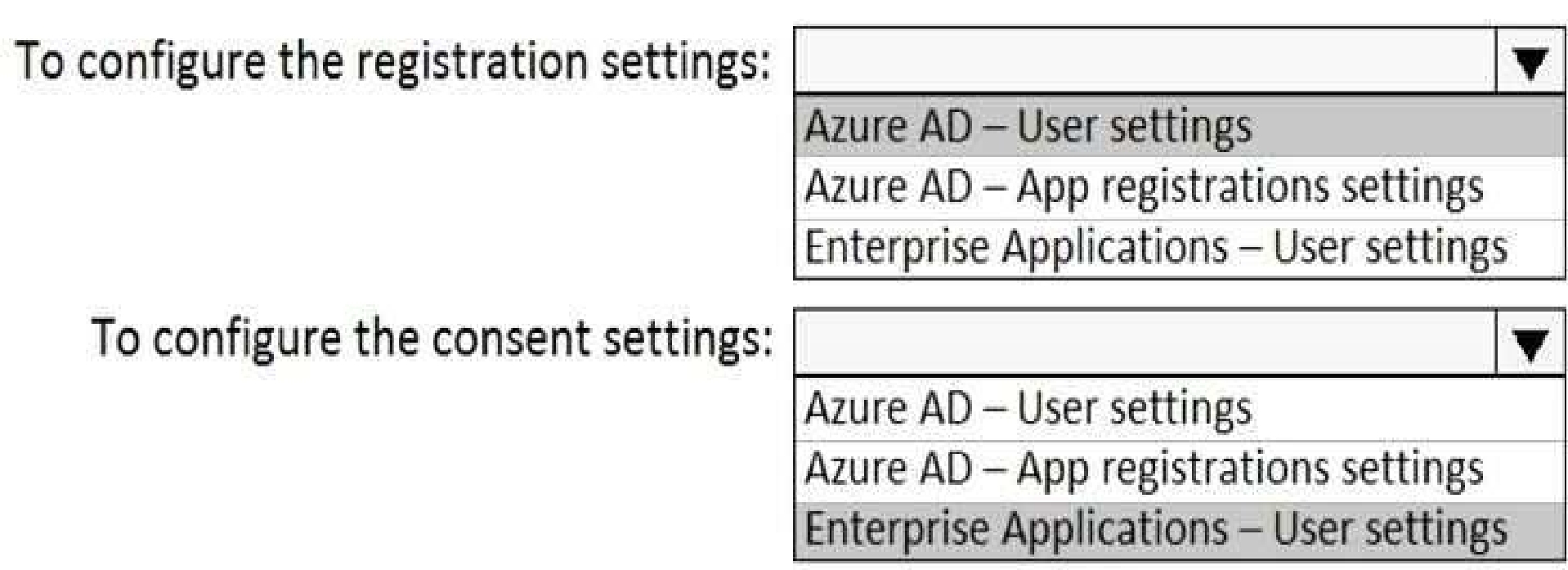Quiz
This is a case study. Case studies are not timed separately. You can use as much exam time as you
would like to complete each case. However, there may be additional case studies and sections on
this exam. You must manage your time to ensure that you are able to complete all questions included
on this exam in the time provided.
To answer the questions included in a case study, you will need to reference information that is
provided in the case study. Case studies might contain exhibits and other resources that provide
more information about the scenario that is described in the case study. Each question is
independent of the other question on this case study.
At the end of this case study, a review screen will appear. This screen allows you to review your
answers and to make changes before you move to the next sections of the exam. After you begin a
new section, you cannot return to this section.
To start the case study
To display the first question on this case study, click the Next button. Use the buttons in the left pane
to explore the content of the case study before you answer the questions. Clicking these buttons
displays information such as business requirements, existing environment, and problem statements.
If the case study has an All Information tab, note that the information displayed is identical to the
information displayed on the subsequent tabs. When you are ready to answer a question, click the
Question button to return to the question.
Overview
Litware, Inc. is a digital media company that has 500 employees in the Chicago area and 20
employees in the San Francisco area.
Existing Environment
Litware has an Azure subscription named Sub1 that has a subscription ID of 43894a43-17c2-4a39-
8cfc-3540c2653ef4.
Sub1 is associated to an Azure Active Directory (Azure AD) tenant named litwareinc.com. The tenant
contains the user objects and the device objects of all the Litware employees and their devices. Each
user is assigned an Azure AD Premium P2 license. Azure AD Privileged Identity Management (PIM) is
activated.
The tenant contains the groups shown in the following table.

The Azure subscription contains the objects shown in the following table.
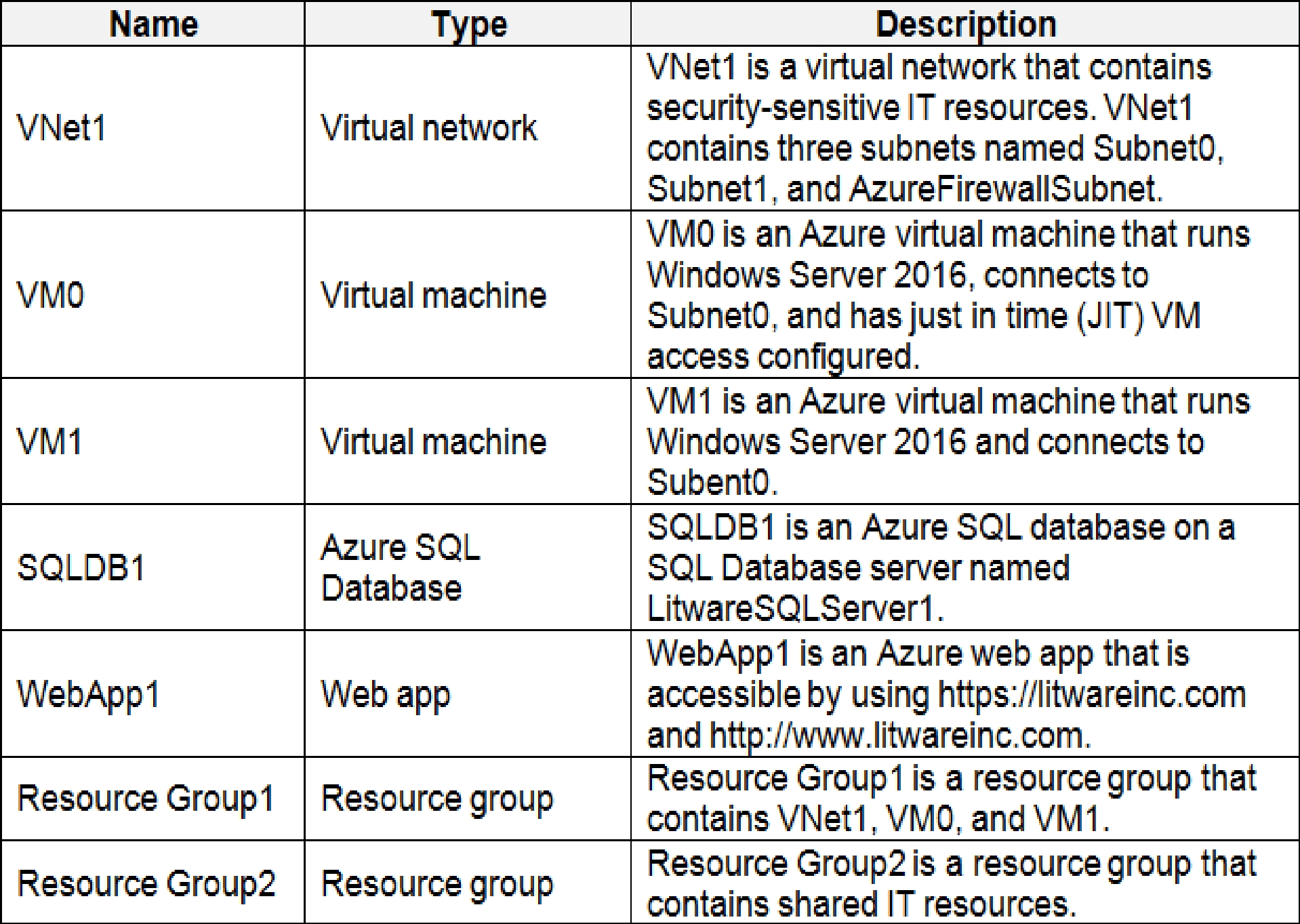
Azure Security Center is set to the Free tier.
Planned changes
Litware plans to deploy the Azure resources shown in the following table.

Litware identifies the following identity and access requirements:
All San Francisco users and their devices must be members of Group1.
The members of Group2 must be assigned the Contributor role to Resource Group2 by using a
permanent eligible assignment.
Users must be prevented from registering applications in Azure AD and from consenting to
applications that access company information on the users’ behalf.
Platform Protection Requirements
Litware identifies the following platform protection requirements:
Microsoft Antimalware must be installed on the virtual machines in Resource Group1.
The members of Group2 must be assigned the Azure Kubernetes Service Cluster Admin Role.
Azure AD users must be to authenticate to AKS1 by using their Azure AD credentials.
Following the implementation of the planned changes, the IT team must be able to connect to VM0
by using JIT VM access.
A new custom RBAC role named Role1 must be used to delegate the administration of the managed
disks in Resource Group1. Role1 must be available only for Resource Group1.
Security Operations Requirements
Litware must be able to customize the operating system security configurations in Azure Security
Center.
What should you do?
Quiz
This is a case study. Case studies are not timed separately. You can use as much exam time as you
would like to complete each case. However, there may be additional case studies and sections on
this exam. You must manage your time to ensure that you are able to complete all questions included
on this exam in the time provided.
To answer the questions included in a case study, you will need to reference information that is
provided in the case study. Case studies might contain exhibits and other resources that provide
more information about the scenario that is described in the case study. Each question is
independent of the other question on this case study.
At the end of this case study, a review screen will appear. This screen allows you to review your
answers and to make changes before you move to the next sections of the exam. After you begin a
new section, you cannot return to this section.
To start the case study
To display the first question on this case study, click the Next button. Use the buttons in the left pane
to explore the content of the case study before you answer the questions. Clicking these buttons
displays information such as business requirements, existing environment, and problem statements.
If the case study has an All Information tab, note that the information displayed is identical to the
information displayed on the subsequent tabs. When you are ready to answer a question, click the
Question button to return to the question.
Overview
Litware, Inc. is a digital media company that has 500 employees in the Chicago area and 20
employees in the San Francisco area.
Existing Environment
Litware has an Azure subscription named Sub1 that has a subscription ID of 43894a43-17c2-4a39-
8cfc-3540c2653ef4.
Sub1 is associated to an Azure Active Directory (Azure AD) tenant named litwareinc.com. The tenant
contains the user objects and the device objects of all the Litware employees and their devices. Each
user is assigned an Azure AD Premium P2 license. Azure AD Privileged Identity Management (PIM) is
activated.
The tenant contains the groups shown in the following table.

The Azure subscription contains the objects shown in the following table.

Azure Security Center is set to the Free tier.
Planned changes
Litware plans to deploy the Azure resources shown in the following table.

Litware identifies the following identity and access requirements:
All San Francisco users and their devices must be members of Group1.
The members of Group2 must be assigned the Contributor role to Resource Group2 by using a
permanent eligible assignment.
Users must be prevented from registering applications in Azure AD and from consenting to
applications that access company information on the users’ behalf.
Platform Protection Requirements
Litware identifies the following platform protection requirements:
Microsoft Antimalware must be installed on the virtual machines in Resource Group1.
The members of Group2 must be assigned the Azure Kubernetes Service Cluster Admin Role.
Azure AD users must be to authenticate to AKS1 by using their Azure AD credentials.
Following the implementation of the planned changes, the IT team must be able to connect to VM0
by using JIT VM access.
A new custom RBAC role named Role1 must be used to delegate the administration of the managed
disks in Resource Group1. Role1 must be available only for Resource Group1.
Security Operations Requirements
Litware must be able to customize the operating system security configurations in Azure Security
Center.
requirements.
What should you do?
Quiz
This is a case study. Case studies are not timed separately. You can use as much exam time as you
would like to complete each case. However, there may be additional case studies and sections on
this exam. You must manage your time to ensure that you are able to complete all questions included
on this exam in the time provided.
To answer the questions included in a case study, you will need to reference information that is
provided in the case study. Case studies might contain exhibits and other resources that provide
more information about the scenario that is described in the case study. Each question is
independent of the other question on this case study.
At the end of this case study, a review screen will appear. This screen allows you to review your
answers and to make changes before you move to the next sections of the exam. After you begin a
new section, you cannot return to this section.
To start the case study
To display the first question on this case study, click the Next button. Use the buttons in the left pane
to explore the content of the case study before you answer the questions. Clicking these buttons
displays information such as business requirements, existing environment, and problem statements.
If the case study has an All Information tab, note that the information displayed is identical to the
information displayed on the subsequent tabs. When you are ready to answer a question, click the
Question button to return to the question.
Overview
Litware, Inc. is a digital media company that has 500 employees in the Chicago area and 20
employees in the San Francisco area.
Existing Environment
Litware has an Azure subscription named Sub1 that has a subscription ID of 43894a43-17c2-4a39-
8cfc-3540c2653ef4.
Sub1 is associated to an Azure Active Directory (Azure AD) tenant named litwareinc.com. The tenant
contains the user objects and the device objects of all the Litware employees and their devices. Each
user is assigned an Azure AD Premium P2 license. Azure AD Privileged Identity Management (PIM) is
activated.
The tenant contains the groups shown in the following table.

The Azure subscription contains the objects shown in the following table.

Azure Security Center is set to the Free tier.
Planned changes
Litware plans to deploy the Azure resources shown in the following table.

Litware identifies the following identity and access requirements:
All San Francisco users and their devices must be members of Group1.
The members of Group2 must be assigned the Contributor role to Resource Group2 by using a
permanent eligible assignment.
Users must be prevented from registering applications in Azure AD and from consenting to
applications that access company information on the users’ behalf.
Platform Protection Requirements
Litware identifies the following platform protection requirements:
Microsoft Antimalware must be installed on the virtual machines in Resource Group1.
The members of Group2 must be assigned the Azure Kubernetes Service Cluster Admin Role.
Azure AD users must be to authenticate to AKS1 by using their Azure AD credentials.
Following the implementation of the planned changes, the IT team must be able to connect to VM0
by using JIT VM access.
A new custom RBAC role named Role1 must be used to delegate the administration of the managed
disks in Resource Group1. Role1 must be available only for Resource Group1.
Security Operations Requirements
Litware must be able to customize the operating system security configurations in Azure Security
Center.
What should you do first?
Quiz
This is a case study. Case studies are not timed separately. You can use as much exam time as you
would like to complete each case. However, there may be additional case studies and sections on
this exam. You must manage your time to ensure that you are able to complete all questions included
on this exam in the time provided.
To answer the questions included in a case study, you will need to reference information that is
provided in the case study. Case studies might contain exhibits and other resources that provide
more information about the scenario that is described in the case study. Each question is
independent of the other question on this case study.
At the end of this case study, a review screen will appear. This screen allows you to review your
answers and to make changes before you move to the next sections of the exam. After you begin a
new section, you cannot return to this section.
To start the case study
To display the first question on this case study, click the Next button. Use the buttons in the left pane
to explore the content of the case study before you answer the questions. Clicking these buttons
displays information such as business requirements, existing environment, and problem statements.
If the case study has an All Information tab, note that the information displayed is identical to the
information displayed on the subsequent tabs. When you are ready to answer a question, click the
Question button to return to the question.
Overview
Litware, Inc. is a digital media company that has 500 employees in the Chicago area and 20
employees in the San Francisco area.
Existing Environment
Litware has an Azure subscription named Sub1 that has a subscription ID of 43894a43-17c2-4a39-
8cfc-3540c2653ef4.
Sub1 is associated to an Azure Active Directory (Azure AD) tenant named litwareinc.com. The tenant
contains the user objects and the device objects of all the Litware employees and their devices. Each
user is assigned an Azure AD Premium P2 license. Azure AD Privileged Identity Management (PIM) is
activated.
The tenant contains the groups shown in the following table.

The Azure subscription contains the objects shown in the following table.

Azure Security Center is set to the Free tier.
Planned changes
Litware plans to deploy the Azure resources shown in the following table.

Litware identifies the following identity and access requirements:
All San Francisco users and their devices must be members of Group1.
The members of Group2 must be assigned the Contributor role to Resource Group2 by using a
permanent eligible assignment.
Users must be prevented from registering applications in Azure AD and from consenting to
applications that access company information on the users’ behalf.
Platform Protection Requirements
Litware identifies the following platform protection requirements:
Microsoft Antimalware must be installed on the virtual machines in Resource Group1.
The members of Group2 must be assigned the Azure Kubernetes Service Cluster Admin Role.
Azure AD users must be to authenticate to AKS1 by using their Azure AD credentials.
Following the implementation of the planned changes, the IT team must be able to connect to VM0
by using JIT VM access.
A new custom RBAC role named Role1 must be used to delegate the administration of the managed
disks in Resource Group1. Role1 must be available only for Resource Group1.
Security Operations Requirements
Litware must be able to customize the operating system security configurations in Azure Security
Center.
Which two actions should you perform? Each correct answer presents part of the solution.
NOTE: Each correct selection is worth one point.
Quiz
This is a case study. Case studies are not timed separately. You can use as much exam time as you
would like to complete each case. However, there may be additional case studies and sections on
this exam. You must manage your time to ensure that you are able to complete all questions included
on this exam in the time provided.
To answer the questions included in a case study, you will need to reference information that is
provided in the case study. Case studies might contain exhibits and other resources that provide
more information about the scenario that is described in the case study. Each question is
independent of the other question on this case study.
At the end of this case study, a review screen will appear. This screen allows you to review your
answers and to make changes before you move to the next sections of the exam. After you begin a
new section, you cannot return to this section.
To start the case study
To display the first question on this case study, click the Next button. Use the buttons in the left pane
to explore the content of the case study before you answer the questions. Clicking these buttons
displays information such as business requirements, existing environment, and problem statements.
If the case study has an All Information tab, note that the information displayed is identical to the
information displayed on the subsequent tabs. When you are ready to answer a question, click the
Question button to return to the question.
Overview
Litware, Inc. is a digital media company that has 500 employees in the Chicago area and 20
employees in the San Francisco area.
Existing Environment
Litware has an Azure subscription named Sub1 that has a subscription ID of 43894a43-17c2-4a39-
8cfc-3540c2653ef4.
Sub1 is associated to an Azure Active Directory (Azure AD) tenant named litwareinc.com. The tenant
contains the user objects and the device objects of all the Litware employees and their devices. Each
user is assigned an Azure AD Premium P2 license. Azure AD Privileged Identity Management (PIM) is
activated.
The tenant contains the groups shown in the following table.

The Azure subscription contains the objects shown in the following table.

Azure Security Center is set to the Free tier.
Planned changes
Litware plans to deploy the Azure resources shown in the following table.

Litware identifies the following identity and access requirements:
All San Francisco users and their devices must be members of Group1.
The members of Group2 must be assigned the Contributor role to Resource Group2 by using a
permanent eligible assignment.
Users must be prevented from registering applications in Azure AD and from consenting to
applications that access company information on the users’ behalf.
Platform Protection Requirements
Litware identifies the following platform protection requirements:
Microsoft Antimalware must be installed on the virtual machines in Resource Group1.
The members of Group2 must be assigned the Azure Kubernetes Service Cluster Admin Role.
Azure AD users must be to authenticate to AKS1 by using their Azure AD credentials.
Following the implementation of the planned changes, the IT team must be able to connect to VM0
by using JIT VM access.
A new custom RBAC role named Role1 must be used to delegate the administration of the managed
disks in Resource Group1. Role1 must be available only for Resource Group1.
Security Operations Requirements
Litware must be able to customize the operating system security configurations in Azure Security
Center.
How should you complete the role definition of Role1? To answer, select the appropriate options in
the answer area.
NOTE: Each correct selection is worth one point.
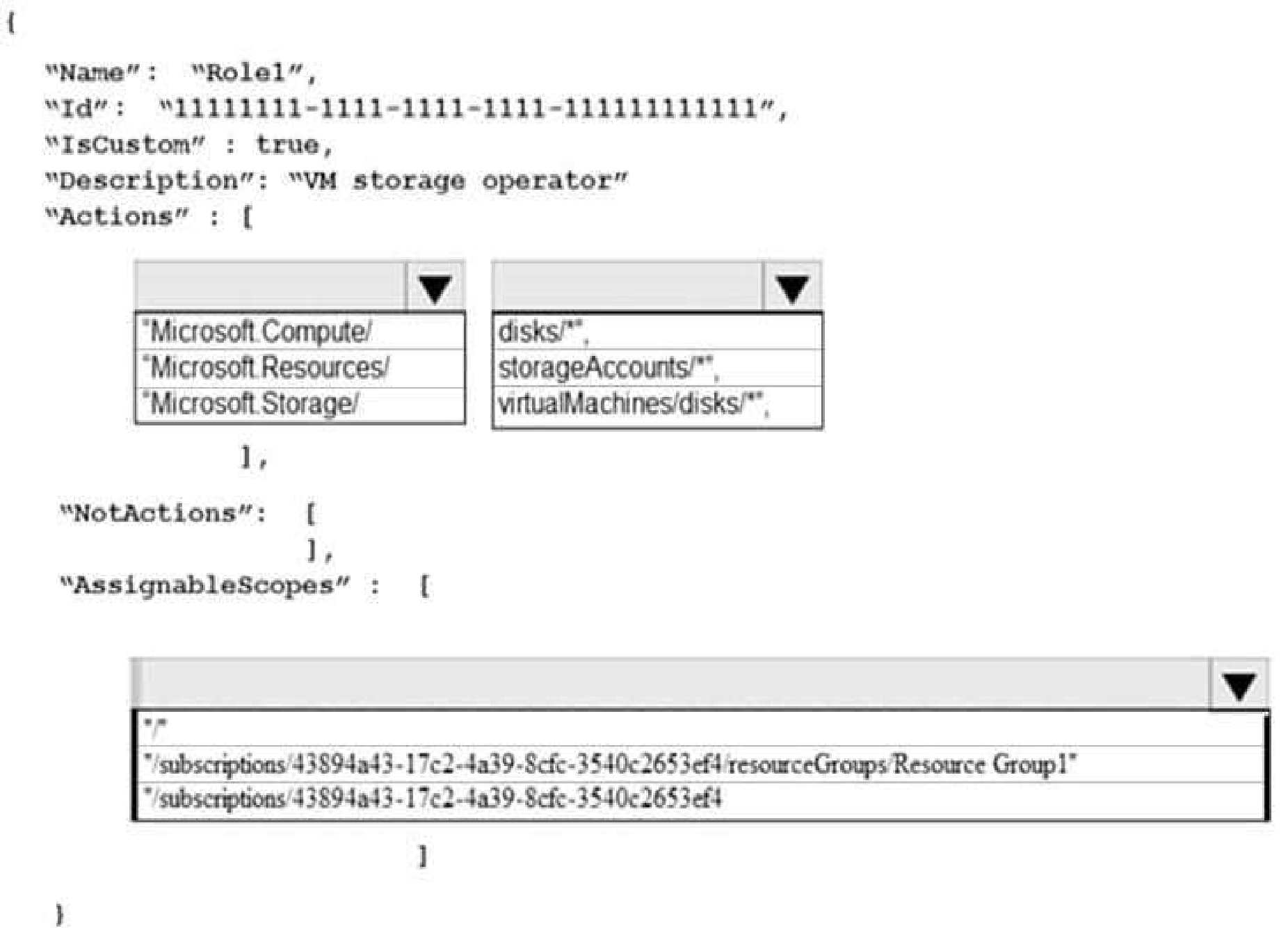
2) disks
3) /subscrption/{subscriptionId}/resourceGroups/{Resource Group Id}
A new custom RBAC role named Role1 must be used to delegate the administration of the managed
disks in Resource Group1. Role1 must be available only for Resource Group1.
Quiz
This is a case study. Case studies are not timed separately. You can use as much exam time as you
would like to complete each case. However, there may be additional case studies and sections on
this exam. You must manage your time to ensure that you are able to complete all questions included
on this exam in the time provided.
To answer the questions included in a case study, you will need to reference information that is
provided in the case study. Case studies might contain exhibits and other resources that provide
more information about the scenario that is described in the case study. Each question is
independent of the other question on this case study.
At the end of this case study, a review screen will appear. This screen allows you to review your
answers and to make changes before you move to the next sections of the exam. After you begin a
new section, you cannot return to this section.
To start the case study
To display the first question on this case study, click the Next button. Use the buttons in the left pane
to explore the content of the case study before you answer the questions. Clicking these buttons
displays information such as business requirements, existing environment, and problem statements.
If the case study has an All Information tab, note that the information displayed is identical to the
information displayed on the subsequent tabs. When you are ready to answer a question, click the
Question button to return to the question.
Overview
Litware, Inc. is a digital media company that has 500 employees in the Chicago area and 20
employees in the San Francisco area.
Existing Environment
Litware has an Azure subscription named Sub1 that has a subscription ID of 43894a43-17c2-4a39-
8cfc-3540c2653ef4.
Sub1 is associated to an Azure Active Directory (Azure AD) tenant named litwareinc.com. The tenant
contains the user objects and the device objects of all the Litware employees and their devices. Each
user is assigned an Azure AD Premium P2 license. Azure AD Privileged Identity Management (PIM) is
activated.
The tenant contains the groups shown in the following table.

The Azure subscription contains the objects shown in the following table.

Azure Security Center is set to the Free tier.
Planned changes
Litware plans to deploy the Azure resources shown in the following table.

Litware identifies the following identity and access requirements:
All San Francisco users and their devices must be members of Group1.
The members of Group2 must be assigned the Contributor role to Resource Group2 by using a
permanent eligible assignment.
Users must be prevented from registering applications in Azure AD and from consenting to
applications that access company information on the users’ behalf.
Platform Protection Requirements
Litware identifies the following platform protection requirements:
Microsoft Antimalware must be installed on the virtual machines in Resource Group1.
The members of Group2 must be assigned the Azure Kubernetes Service Cluster Admin Role.
Azure AD users must be to authenticate to AKS1 by using their Azure AD credentials.
Following the implementation of the planned changes, the IT team must be able to connect to VM0
by using JIT VM access.
A new custom RBAC role named Role1 must be used to delegate the administration of the managed
disks in Resource Group1. Role1 must be available only for Resource Group1.
Security Operations Requirements
Litware must be able to customize the operating system security configurations in Azure Security
Center.
You need to configure SQLDB1 to meet the data and application requirements.
Which three actions should you recommend be performed in sequence? To answer, move the
appropriate actions from the list of actions to the answer area and arrange them in the correct order.
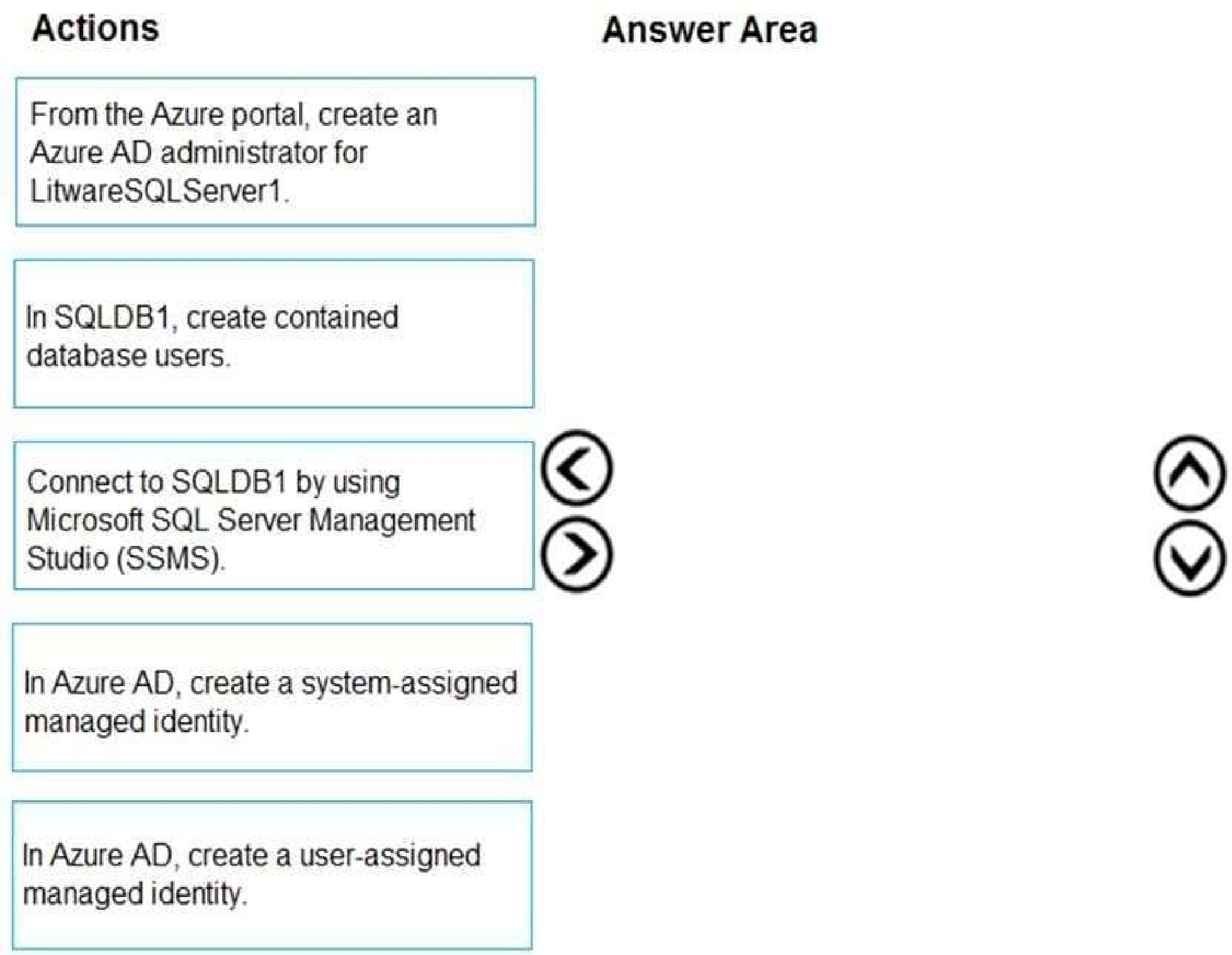
Connect to SQLDB1 by using SSMS
In SQLDB1, create contained database users
https://www.youtube.com/watch?v=pEPyPsGEevw
Quiz
This is a case study. Case studies are not timed separately. You can use as much exam time as you
would like to complete each case. However, there may be additional case studies and sections on
this exam. You must manage your time to ensure that you are able to complete all questions included
on this exam in the time provided.
To answer the questions included in a case study, you will need to reference information that is
provided in the case study. Case studies might contain exhibits and other resources that provide
more information about the scenario that is described in the case study. Each question is
independent of the other question on this case study.
At the end of this case study, a review screen will appear. This screen allows you to review your
answers and to make changes before you move to the next sections of the exam. After you begin a
new section, you cannot return to this section.
To start the case study
To display the first question on this case study, click the Next button. Use the buttons in the left pane
to explore the content of the case study before you answer the questions. Clicking these buttons
displays information such as business requirements, existing environment, and problem statements.
If the case study has an All Information tab, note that the information displayed is identical to the
information displayed on the subsequent tabs. When you are ready to answer a question, click the
Question button to return to the question.
Overview
Litware, Inc. is a digital media company that has 500 employees in the Chicago area and 20
employees in the San Francisco area.
Existing Environment
Litware has an Azure subscription named Sub1 that has a subscription ID of 43894a43-17c2-4a39-
8cfc-3540c2653ef4.
Sub1 is associated to an Azure Active Directory (Azure AD) tenant named litwareinc.com. The tenant
contains the user objects and the device objects of all the Litware employees and their devices. Each
user is assigned an Azure AD Premium P2 license. Azure AD Privileged Identity Management (PIM) is
activated.
The tenant contains the groups shown in the following table.

The Azure subscription contains the objects shown in the following table.

Azure Security Center is set to the Free tier.
Planned changes
Litware plans to deploy the Azure resources shown in the following table.

Litware identifies the following identity and access requirements:
All San Francisco users and their devices must be members of Group1.
The members of Group2 must be assigned the Contributor role to Resource Group2 by using a
permanent eligible assignment.
Users must be prevented from registering applications in Azure AD and from consenting to
applications that access company information on the users’ behalf.
Platform Protection Requirements
Litware identifies the following platform protection requirements:
Microsoft Antimalware must be installed on the virtual machines in Resource Group1.
The members of Group2 must be assigned the Azure Kubernetes Service Cluster Admin Role.
Azure AD users must be to authenticate to AKS1 by using their Azure AD credentials.
Following the implementation of the planned changes, the IT team must be able to connect to VM0
by using JIT VM access.
A new custom RBAC role named Role1 must be used to delegate the administration of the managed
disks in Resource Group1. Role1 must be available only for Resource Group1.
Security Operations Requirements
Litware must be able to customize the operating system security configurations in Azure Security
Center.
What should you do? To answer, select the appropriate options in the answer area.
NOTE: Each correct selection is worth one point.
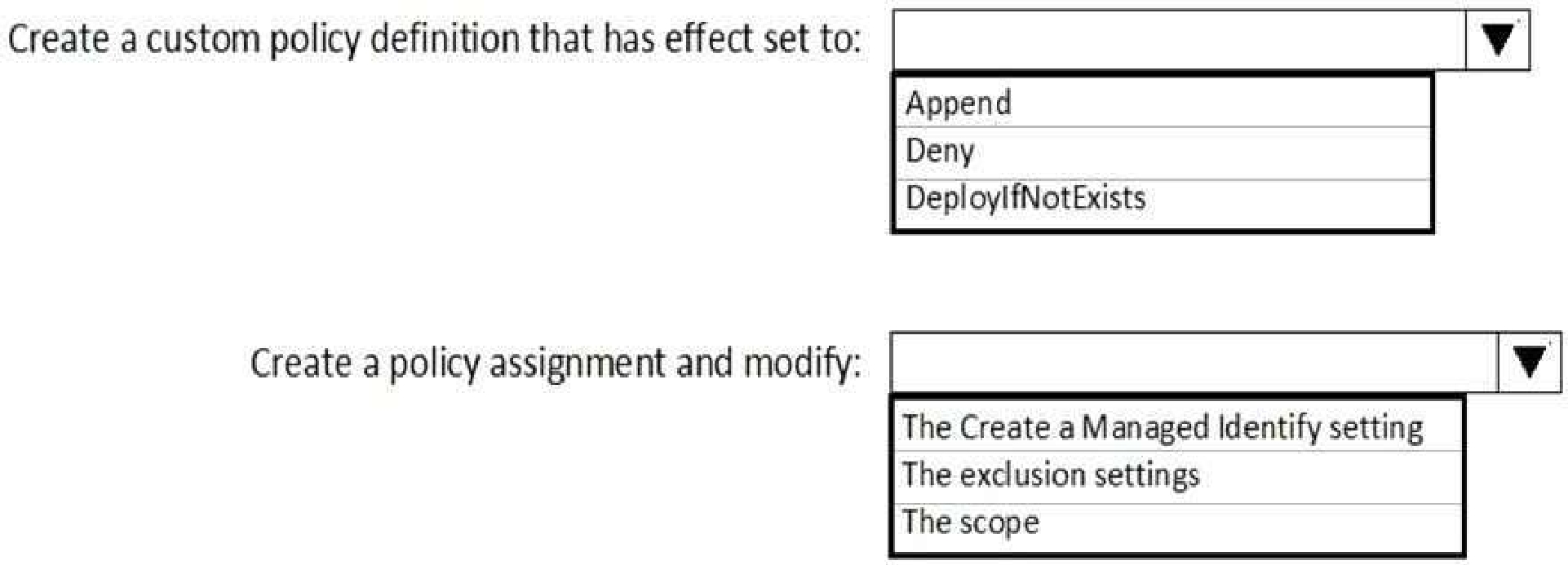
2. Scope
Quiz
This is a case study. Case studies are not timed separately. You can use as much exam time as you
would like to complete each case. However, there may be additional case studies and sections on
this exam. You must manage your time to ensure that you are able to complete all questions included
on this exam in the time provided.
To answer the questions included in a case study, you will need to reference information that is
provided in the case study. Case studies might contain exhibits and other resources that provide
more information about the scenario that is described in the case study. Each question is
independent of the other question on this case study.
At the end of this case study, a review screen will appear. This screen allows you to review your
answers and to make changes before you move to the next sections of the exam. After you begin a
new section, you cannot return to this section.
To start the case study
To display the first question on this case study, click the Next button. Use the buttons in the left pane
to explore the content of the case study before you answer the questions. Clicking these buttons
displays information such as business requirements, existing environment, and problem statements.
If the case study has an All Information tab, note that the information displayed is identical to the
information displayed on the subsequent tabs. When you are ready to answer a question, click the
Question button to return to the question.
Overview
Litware, Inc. is a digital media company that has 500 employees in the Chicago area and 20
employees in the San Francisco area.
Existing Environment
Litware has an Azure subscription named Sub1 that has a subscription ID of 43894a43-17c2-4a39-
8cfc-3540c2653ef4.
Sub1 is associated to an Azure Active Directory (Azure AD) tenant named litwareinc.com. The tenant
contains the user objects and the device objects of all the Litware employees and their devices. Each
user is assigned an Azure AD Premium P2 license. Azure AD Privileged Identity Management (PIM) is
activated.
The tenant contains the groups shown in the following table.

The Azure subscription contains the objects shown in the following table.

Azure Security Center is set to the Free tier.
Planned changes
Litware plans to deploy the Azure resources shown in the following table.

Litware identifies the following identity and access requirements:
All San Francisco users and their devices must be members of Group1.
The members of Group2 must be assigned the Contributor role to Resource Group2 by using a
permanent eligible assignment.
Users must be prevented from registering applications in Azure AD and from consenting to
applications that access company information on the users’ behalf.
Platform Protection Requirements
Litware identifies the following platform protection requirements:
Microsoft Antimalware must be installed on the virtual machines in Resource Group1.
The members of Group2 must be assigned the Azure Kubernetes Service Cluster Admin Role.
Azure AD users must be to authenticate to AKS1 by using their Azure AD credentials.
Following the implementation of the planned changes, the IT team must be able to connect to VM0
by using JIT VM access.
A new custom RBAC role named Role1 must be used to delegate the administration of the managed
disks in Resource Group1. Role1 must be available only for Resource Group1.
Security Operations Requirements
Litware must be able to customize the operating system security configurations in Azure Security
Center.
You need to deploy AKS1 to meet the platform protection requirements.
Which four actions should you perform in sequence? To answer, move the appropriate actions from
the list of actions to the answer area and arrange them in the correct order.
NOTE: More than one order of answer choices is correct. You will receive credit for any of the correct
orders you select.
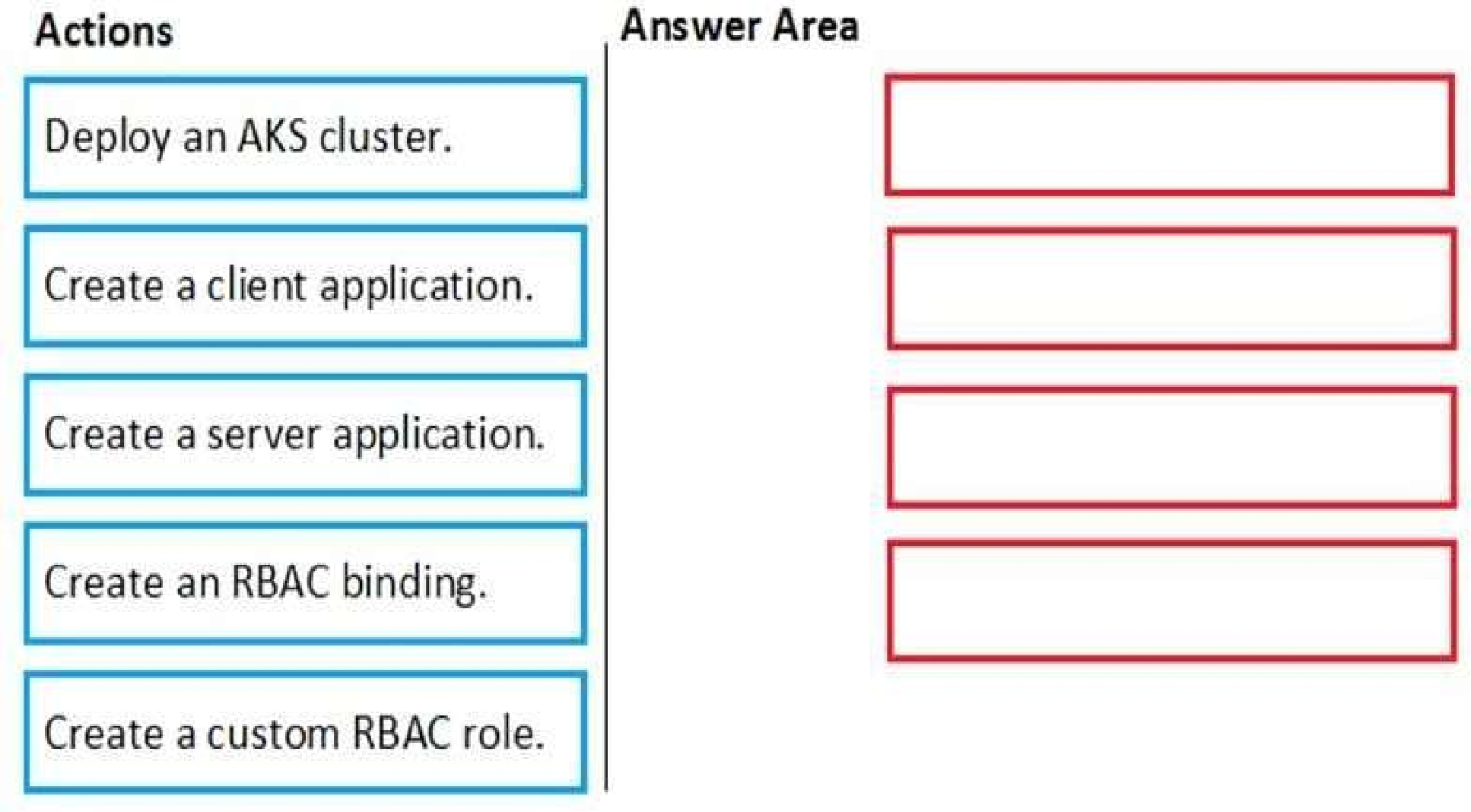
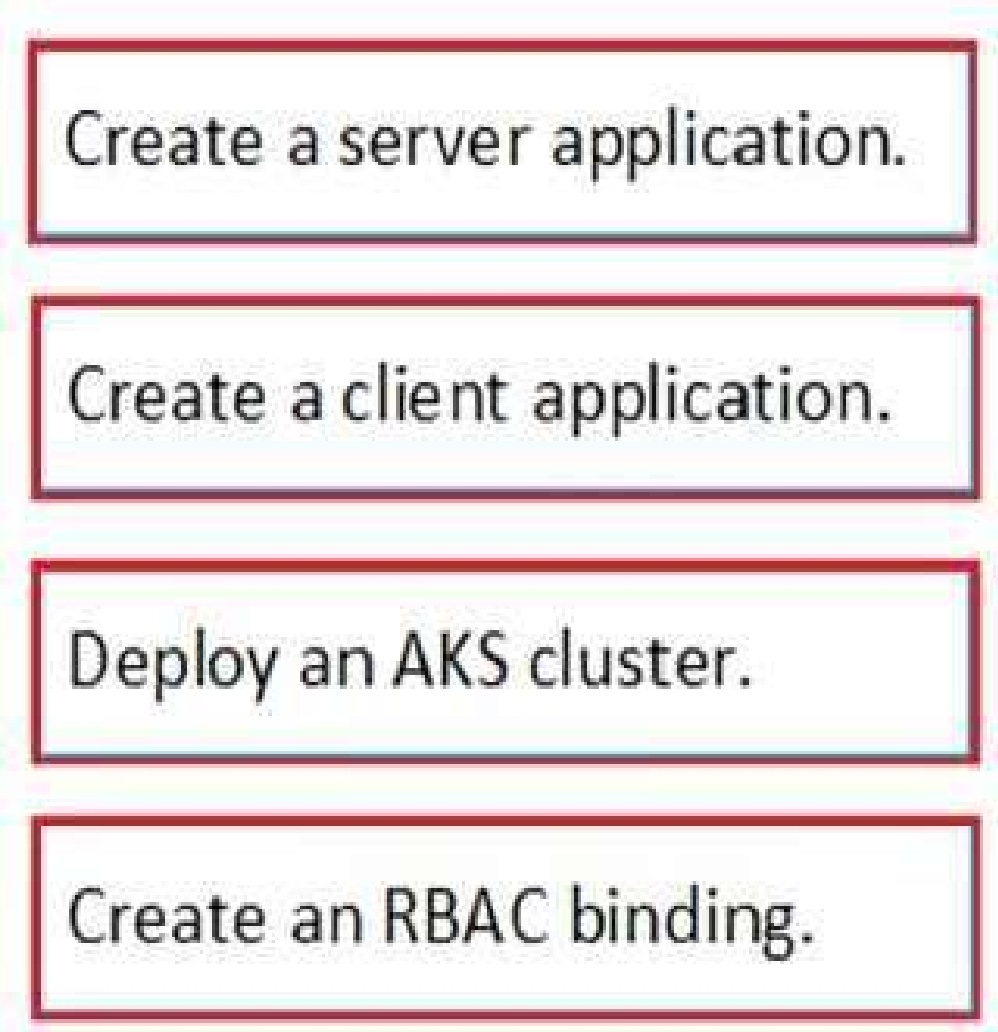
Scenario: Azure AD users must be to authenticate to AKS1 by using their Azure AD credentials.
Litewire plans to deploy AKS1, which is a managed AKS (Azure Kubernetes Services) cluster.
Step 1: Create a server application
To provide Azure AD authentication for an AKS cluster, two Azure AD applications are created. The
first application is a server component that provides user authentication.
Step 2: Create a client application
The second application is a client component that's used when you're prompted by the CLI for
authentication. This client application uses the server application for the actual authentication of the
credentials provided by the client.
Step 3: Deploy an AKS cluster.
Use the az group create command to create a resource group for the AKS cluster.
Use the az aks create command to deploy the AKS cluster.
Step 4: Create an RBAC binding.
Before you use an Azure Active Directory account with an AKS cluster, you must create role-binding
or cluster role-binding. Roles define the permissions to grant, and bindings apply them to desired
users. These assignments can be applied to a given namespace, or across the entire cluster.
Reference:
https://docs.microsoft.com/en-us/azure/aks/azure-ad-integration
Quiz
This is a case study. Case studies are not timed separately. You can use as much exam time as you
would like to complete each case. However, there may be additional case studies and sections on
this exam. You must manage your time to ensure that you are able to complete all questions included
on this exam in the time provided.
To answer the questions included in a case study, you will need to reference information that is
provided in the case study. Case studies might contain exhibits and other resources that provide
more information about the scenario that is described in the case study. Each question is
independent of the other question on this case study.
At the end of this case study, a review screen will appear. This screen allows you to review your
answers and to make changes before you move to the next sections of the exam. After you begin a
new section, you cannot return to this section.
To start the case study
To display the first question on this case study, click the Next button. Use the buttons in the left pane
to explore the content of the case study before you answer the questions. Clicking these buttons
displays information such as business requirements, existing environment, and problem statements.
If the case study has an All Information tab, note that the information displayed is identical to the
information displayed on the subsequent tabs. When you are ready to answer a question, click the
Question button to return to the question.
Overview
Litware, Inc. is a digital media company that has 500 employees in the Chicago area and 20
employees in the San Francisco area.
Existing Environment
Litware has an Azure subscription named Sub1 that has a subscription ID of 43894a43-17c2-4a39-
8cfc-3540c2653ef4.
Sub1 is associated to an Azure Active Directory (Azure AD) tenant named litwareinc.com. The tenant
contains the user objects and the device objects of all the Litware employees and their devices. Each
user is assigned an Azure AD Premium P2 license. Azure AD Privileged Identity Management (PIM) is
activated.
The tenant contains the groups shown in the following table.

The Azure subscription contains the objects shown in the following table.

Azure Security Center is set to the Free tier.
Planned changes
Litware plans to deploy the Azure resources shown in the following table.

Litware identifies the following identity and access requirements:
All San Francisco users and their devices must be members of Group1.
The members of Group2 must be assigned the Contributor role to Resource Group2 by using a
permanent eligible assignment.
Users must be prevented from registering applications in Azure AD and from consenting to
applications that access company information on the users’ behalf.
Platform Protection Requirements
Litware identifies the following platform protection requirements:
Microsoft Antimalware must be installed on the virtual machines in Resource Group1.
The members of Group2 must be assigned the Azure Kubernetes Service Cluster Admin Role.
Azure AD users must be to authenticate to AKS1 by using their Azure AD credentials.
Following the implementation of the planned changes, the IT team must be able to connect to VM0
by using JIT VM access.
A new custom RBAC role named Role1 must be used to delegate the administration of the managed
disks in Resource Group1. Role1 must be available only for Resource Group1.
Security Operations Requirements
Litware must be able to customize the operating system security configurations in Azure Security
Center.
identity and access requirements.
What should you use in the Azure portal? To answer, select the appropriate options in the answer
area.
NOTE: Each correct selection is worth one point.
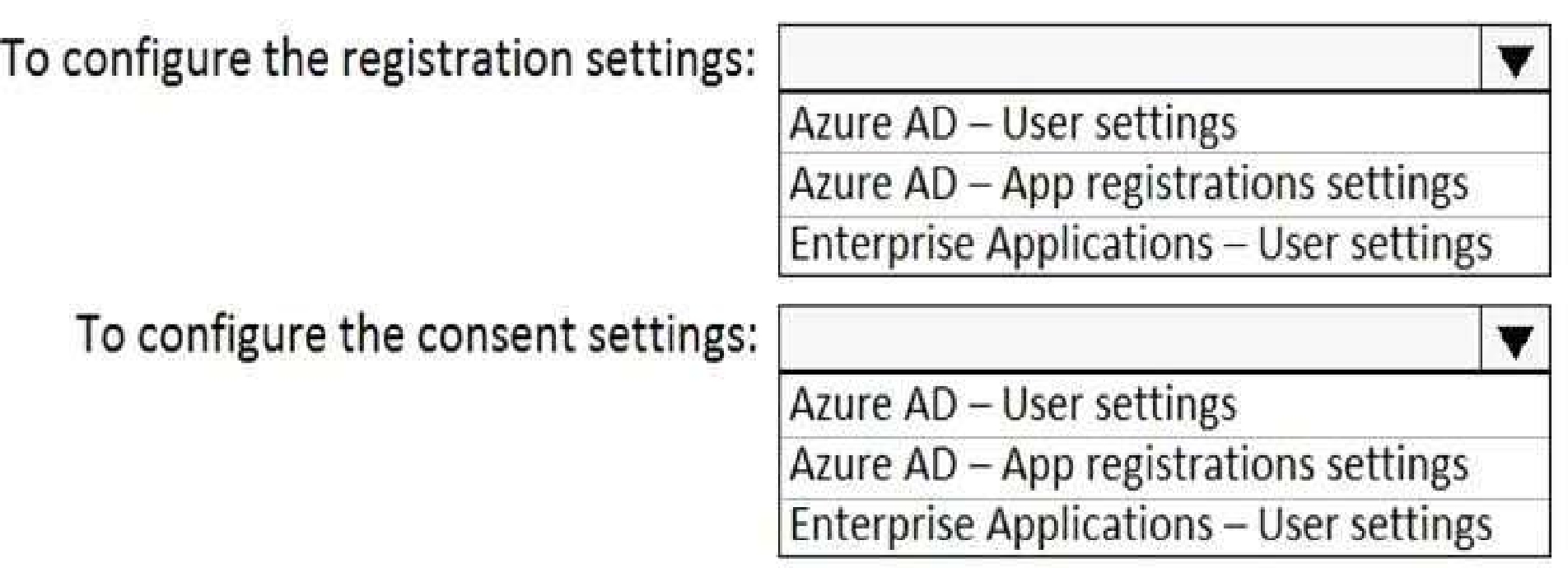
Quiz
This is a case study. Case studies are not timed separately. You can use as much exam time as you
would like to complete each case. However, there may be additional case studies and sections on
this exam. You must manage your time to ensure that you are able to complete all questions included
on this exam in the time provided.
To answer the questions included in a case study, you will need to reference information that is
provided in the case study. Case studies might contain exhibits and other resources that provide
more information about the scenario that is described in the case study. Each question is
independent of the other question on this case study.
At the end of this case study, a review screen will appear. This screen allows you to review your
answers and to make changes before you move to the next sections of the exam. After you begin a
new section, you cannot return to this section.
To start the case study
To display the first question on this case study, click the Next button. Use the buttons in the left pane
to explore the content of the case study before you answer the questions. Clicking these buttons
displays information such as business requirements, existing environment, and problem statements.
If the case study has an All Information tab, note that the information displayed is identical to the
information displayed on the subsequent tabs. When you are ready to answer a question, click the
Question button to return to the question.
Overview
Contoso, Ltd. is a consulting company that has a main office in Montreal and two branch offices in
Seattle and New York.
The company hosts its entire server infrastructure in Azure.
Contoso has two Azure subscriptions named Sub1 and Sub2. Both subscriptions are associated to an
Azure Active Directory (Azure AD) tenant named contoso.com.
Technical requirements
Contoso identifies the following technical requirements:
Deploy Azure Firewall to VNetWork1 in Sub2.
Register an application named App2 in contoso.com.
Whenever possible, use the principle of least privilege.
Enable Azure AD Privileged Identity Management (PIM) for contoso.com
Existing Environment
Azure AD
Contoso.com contains the users shown in the following table.
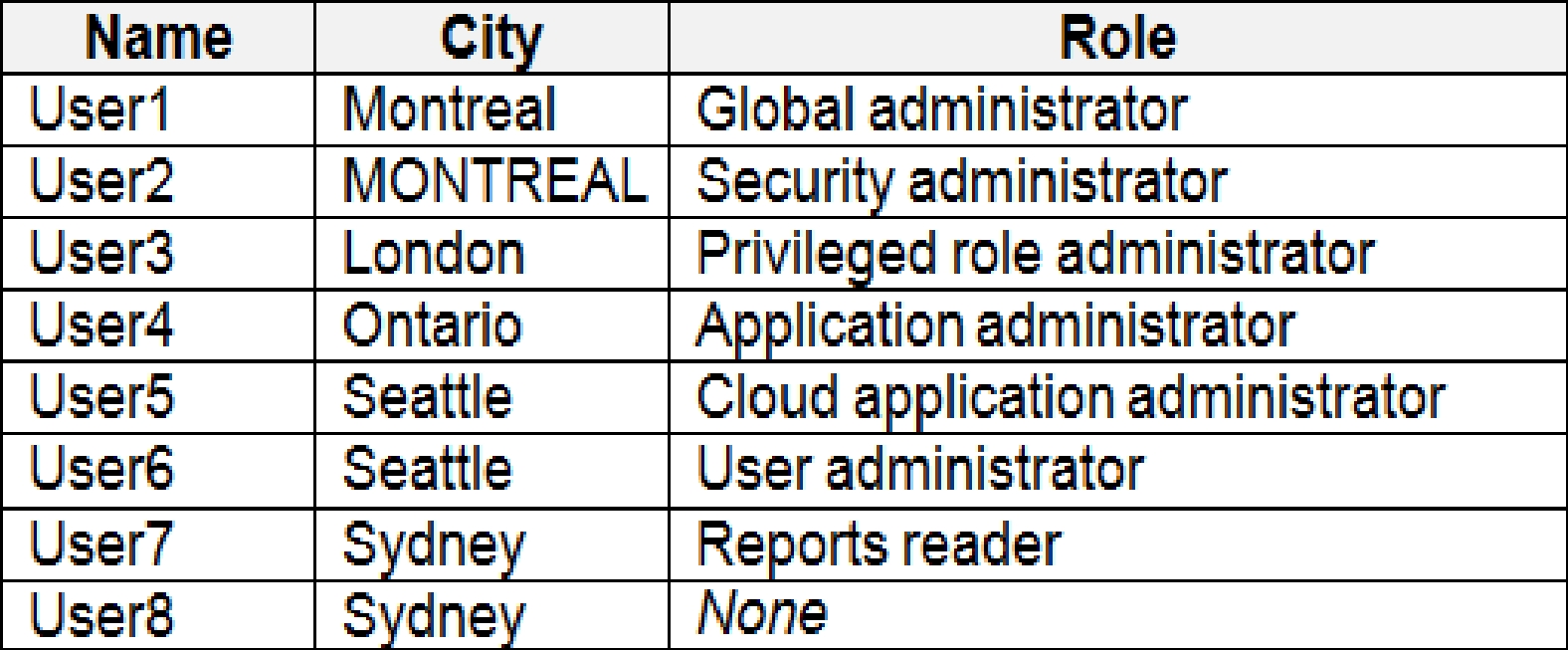
Contoso.com contains the security groups shown in the following table.

Sub1
Sub1 contains six resource groups named RG1, RG2, RG3, RG4, RG5, and RG6.
User2 creates the virtual networks shown in the following table.
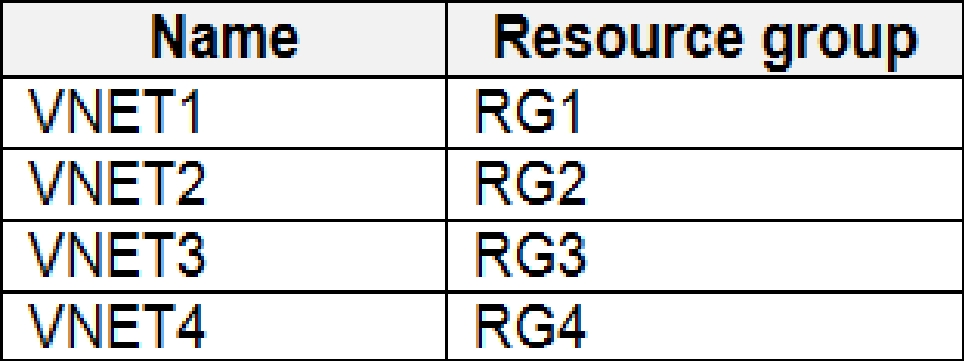
Sub1 contains the locks shown in the following table.

Sub1 contains the Azure policies shown in the following table.

Sub2

Sub2 contains the virtual machines shown in the following table.

All virtual machines have the public IP addresses and the Web Server (IIS) role installed. The firewalls
for each virtual machine allow ping requests and web requests.
Sub2 contains the network security groups (NSGs) shown in the following table.
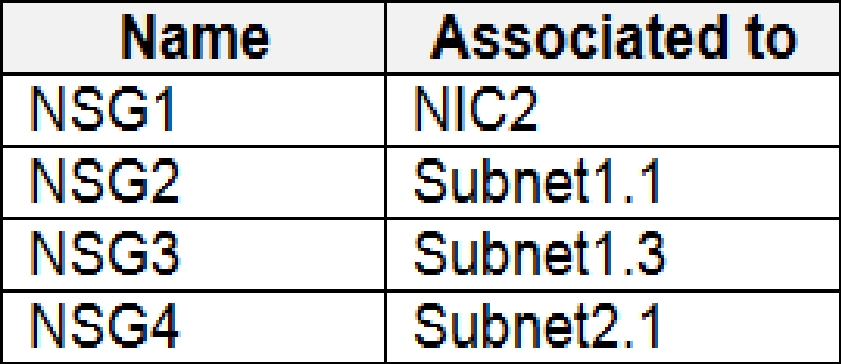
NSG1 has the inbound security rules shown in the following table.

NSG2 has the inbound security rules shown in the following table.

NSG3 has the inbound security rules shown in the following table.

NSG4 has the inbound security rules shown in the following table.

NSG1, NSG2, NSG3, and NSG4 have the outbound security rules shown in the following table.

Contoso identifies the following technical requirements:
Deploy Azure Firewall to VNetwork1 in Sub2.
Register an application named App2 in contoso.com.
Whenever possible, use the principle of least privilege.
Enable Azure AD Privileged Identity Management (PIM) for contoso.com.
What should you do first?
Microsoft Certified: Azure Security Engineer Associate Practice test unlocks all online simulator questions
Thank you for choosing the free version of the Microsoft Certified: Azure Security Engineer Associate practice test! Further deepen your knowledge on Microsoft Simulator; by unlocking the full version of our Microsoft Certified: Azure Security Engineer Associate Simulator you will be able to take tests with over 316 constantly updated questions and easily pass your exam. 98% of people pass the exam in the first attempt after preparing with our 316 questions.
BUY NOWWhat to expect from our Microsoft Certified: Azure Security Engineer Associate practice tests and how to prepare for any exam?
The Microsoft Certified: Azure Security Engineer Associate Simulator Practice Tests are part of the Microsoft Database and are the best way to prepare for any Microsoft Certified: Azure Security Engineer Associate exam. The Microsoft Certified: Azure Security Engineer Associate practice tests consist of 316 questions and are written by experts to help you and prepare you to pass the exam on the first attempt. The Microsoft Certified: Azure Security Engineer Associate database includes questions from previous and other exams, which means you will be able to practice simulating past and future questions. Preparation with Microsoft Certified: Azure Security Engineer Associate Simulator will also give you an idea of the time it will take to complete each section of the Microsoft Certified: Azure Security Engineer Associate practice test . It is important to note that the Microsoft Certified: Azure Security Engineer Associate Simulator does not replace the classic Microsoft Certified: Azure Security Engineer Associate study guides; however, the Simulator provides valuable insights into what to expect and how much work needs to be done to prepare for the Microsoft Certified: Azure Security Engineer Associate exam.
BUY NOWMicrosoft Certified: Azure Security Engineer Associate Practice test therefore represents an excellent tool to prepare for the actual exam together with our Microsoft practice test . Our Microsoft Certified: Azure Security Engineer Associate Simulator will help you assess your level of preparation and understand your strengths and weaknesses. Below you can read all the quizzes you will find in our Microsoft Certified: Azure Security Engineer Associate Simulator and how our unique Microsoft Certified: Azure Security Engineer Associate Database made up of real questions:
Info quiz:
- Quiz name:Microsoft Certified: Azure Security Engineer Associate
- Total number of questions:316
- Number of questions for the test:50
- Pass score:80%
You can prepare for the Microsoft Certified: Azure Security Engineer Associate exams with our mobile app. It is very easy to use and even works offline in case of network failure, with all the functions you need to study and practice with our Microsoft Certified: Azure Security Engineer Associate Simulator.
Use our Mobile App, available for both Android and iOS devices, with our Microsoft Certified: Azure Security Engineer Associate Simulator . You can use it anywhere and always remember that our mobile app is free and available on all stores.
Our Mobile App contains all Microsoft Certified: Azure Security Engineer Associate practice tests which consist of 316 questions and also provide study material to pass the final Microsoft Certified: Azure Security Engineer Associate exam with guaranteed success. Our Microsoft Certified: Azure Security Engineer Associate database contain hundreds of questions and Microsoft Tests related to Microsoft Certified: Azure Security Engineer Associate Exam. This way you can practice anywhere you want, even offline without the internet.
BUY NOW
